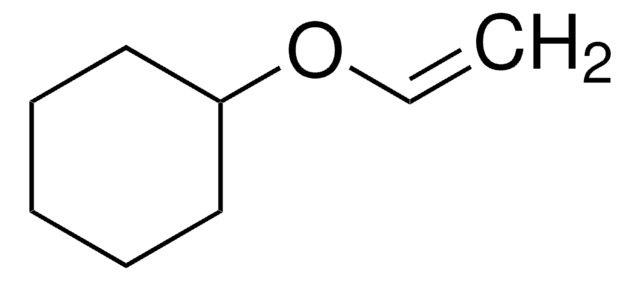Kluczowe dokumenty
123315
1,4-Butanediol divinyl ether
98%
Synonim(y):
1,4-bis(winyloksy)butan, 1,4-diwinyloksybutan, Eter diwinylowy glikolu 1,4-butylenowego
About This Item
Polecane produkty
Poziom jakości
Próba
98%
współczynnik refrakcji
n20/D 1.444 (lit.)
bp
62-64 °C/10 mmHg (lit.)
mp
−8 °C (lit.)
gęstość
0.898 g/mL at 25 °C (lit.)
ciąg SMILES
C=COCCCCOC=C
InChI
1S/C8H14O2/c1-3-9-7-5-6-8-10-4-2/h3-4H,1-2,5-8H2
Klucz InChI
MWZJGRDWJVHRDV-UHFFFAOYSA-N
Powiązane kategorie
Opis ogólny
Zastosowanie
- Comparative physicochemical analysis among 1, 4-butanediol diglycidyl ether cross-linked hyaluronic acid dermal fillers: This study explores the properties of hyaluronic acid dermal fillers cross-linked with 1,4-butanediol diglycidyl ether, focusing on their physicochemical characteristics and performance in cosmetic applications (Zerbinati et al., 2021).
- In-depth characterization of 1, 4-butanediol diglycidyl ether substituted hyaluronic acid hydrogels: An investigation into the properties of hyaluronic acid hydrogels modified with 1,4-butanediol diglycidyl ether, providing insights into their structural and functional enhancements (Zhang et al., 2023).
- Highly Branched Poly(5-amino-1-pentanol-co-1,4-butanediol diacrylate) for High Performance Gene Transfection: Discusses the synthesis and application of a novel branched polymer for gene delivery, highlighting the role of 1,4-butanediol diacrylate in enhancing transfection efficiency (Zeng et al., 2017).
- Tuning thermal, morphological, and physicochemical properties of thermoplastic polyurethanes (TPUs): This study examines the effects of substituting 1,4-butanediol in the synthesis of TPUs, aiming to improve their mechanical properties and performance (Ernzen et al., 2022).
- Cyclodehydration of 1, 4-butanediol over Zr-Al Catalysts: Focuses on the catalytic transformation of 1,4-butanediol to tetrahydrofuran, a critical industrial solvent and intermediate, using zirconium-aluminum catalysts (Li & Chen, 2019).
Hasło ostrzegawcze
Warning
Zwroty wskazujące rodzaj zagrożenia
Zwroty wskazujące środki ostrożności
Klasyfikacja zagrożeń
Aquatic Chronic 2 - Flam. Liq. 3 - Skin Sens. 1B
Zagrożenia dodatkowe
Kod klasy składowania
3 - Flammable liquids
Klasa zagrożenia wodnego (WGK)
WGK 2
Temperatura zapłonu (°F)
139.1 °F - closed cup
Temperatura zapłonu (°C)
59.5 °C - closed cup
Środki ochrony indywidualnej
Eyeshields, Gloves, type ABEK (EN14387) respirator filter
Wybierz jedną z najnowszych wersji:
Masz już ten produkt?
Dokumenty związane z niedawno zakupionymi produktami zostały zamieszczone w Bibliotece dokumentów.
Nasz zespół naukowców ma doświadczenie we wszystkich obszarach badań, w tym w naukach przyrodniczych, materiałoznawstwie, syntezie chemicznej, chromatografii, analityce i wielu innych dziedzinach.
Skontaktuj się z zespołem ds. pomocy technicznej











